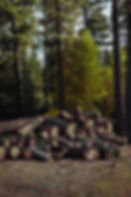

MOON PHASE HARVESTING
Moon Phase Harvesting is an ancient method of preserving timber by cutting wood according to the phases of the moon. Like the tides of the ocean, the moon also influences the rise & fall of the sap in the wood. The wood is cut when the sap is lower, which is in the autumn & winter months i.e. hibernation period. During these months the sap in the tree is at its lowest in the days before the new moon. The lack of sap therefore is a natural protection that prevents insects & fungus from infesting the wood & thus increases its durability.
The trees are left to dry (cure) for 4 – 8 weeks in the forest with their bark, as well as the crown of the tree and a few side branches with leaves left intact. This also reduces the amount of cracking & warping that occurs as the timber dries out.
Further Tips and Information with Moon Phase Harvesting Timber:
The main advantage of cutting at the right time is that one cuts the timber when the nutrient content of the sap is at its lowest. The sap is also understood to be much more stable where it is not on the move. This means that there is a minimal/zero starch/nutrient in the timber that would be what otherwise be a food source that attracts insects and encourages fungal decay. This means that there is no longer any need to apply poisons/preservative treatments to protect ones timber from insect or fungal decay.
-
If you have a choice, it is also advised – though not essential – that the timber you cut is at a higher rather than lower altitude. The higher the altitude the better the overall quality.
-
Furthermore the closer you are to the solstice the better ….so while the time just after the Autumn equinox is still suitable, it is better still to fell as close to the solstice as possible.
-
By far the main thing affecting the quality of the timber is about cutting at the right time of year. However, there are other things that will further improve the quality of timber felled, especially in terms of cracking and warping of timber.
-
Once felled, it is best to leave all the bark and as many branches as practically possible on the tree. For large timbers we recommend leaving the felled trees (typically in the forest) for 3 months with all branches and bark still intact. This is to ensure the timber cures properly, which will leave the timber practically free of splitting and warping. It will also be much lighter so will be much easier to extract from the forest, with less fuel used in transport.
-
In leaving as many of the branches on as possible, it is particularly important to leave the top of the tree intact when felling, as the branches and top, help to pull the sap (which may still contain minute traces of starch, which is the food insects and fungus are after) out to its extremities. This also helps the timber cure more efficiently and evenly, making for a more stable timber. Note that this only works when the timber is cut at the right times of the year, as otherwise insects will attack the timber.
-
Also cut so as to fell the tree/pole down slope so that the cut stem of the tree is at a higher point than the end. This helps with the drawing of the sap to the extremities of the tree for faster and even curing of the timber.
This all helps to leave you with a much more stable timber not subject to warping and avoiding the necessity of kiln drying or excessive time to air cure your timber.
Remember that Insect and fungus proofing of timber meaning no need for preservative treatment of timber as the timber will be of no interest as a food source for insects and fungus. However, your timber will still need protection from the damaging UV rays of the sun if exposed to the elements. We recommend using Envirotouch’s timber products like “outdoor” oil for this purpose. To seal in the oil you can also add an Envirotouch wax balm. Initially you may need to do this a few times to give a chance for the timber to soak up the oil properly. If the timber is exposed to driving rains the oils may leach out so will need some maintenance. Note that this is no different from conventionally treated timber.
NOTE: This knowledge follows 5 years of personal experience and observation with moon phase harvesting in South Africa. This was following my discovery of the technique while visiting Japan, where I met with some scientists studying this phenomena, which is something that is part of their cultural heritage. We have since also made contact with moon phase foresters in Austria and Germany, where it is also part of their culture, as well as the worlds leading academic on the subject - Ernst Zuercher - a professor in wood science at the University of Zurich.
Happy moon phase harvesting.


